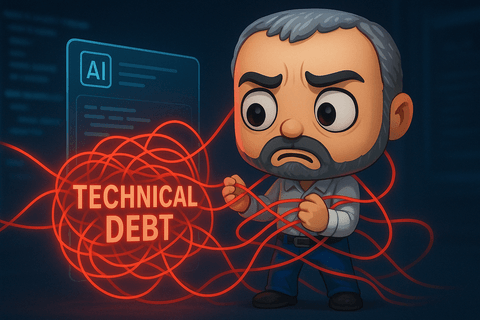Securing AI code with Snyk: A practical guide
Essential security strategies for protecting your AI-first development against hidden vulnerabilities

That AI code felt productive… until the hidden flaws surfaced
Remember the rush? Using an AI assistant, generating vast amounts of code, shipping features faster than ever. It felt like accelerating development significantly.
But then comes the reality check. A subtle bug emerges weeks later. A security audit flags unexpected issues. Or you simply need to modify the code and realize… you don’t fully grasp how it works. Why that specific library call? What assumptions underpin this generated logic?
That sinking feeling? That’s the common challenge of AI-assisted development: initial speed masking underlying fragility and lost context. Hours saved in generation become days lost in debugging and patching security holes. According to Snyk’s 2024 State of Open Source Security report, this isn’t paranoia: while 80% of teams trust AI coding tools, a significant 59% simultaneously worry about the new vulnerabilities these tools might introduce. They are right to worry.
AI code doesn’t exist in a vacuum. It interacts with complex libraries, runs in specific environments, and inherits the risks of its dependencies. Relying on AI speed without deep, context-aware security is like building a skyscraper on sand. Your productivity gains may be undermined if the foundation is insecure.
Security tooling for AI development has evolved alongside the technology itself. While various approaches and tools exist in the application security marketplace, this guide examines how Snyk’s integrated SAST, DAST principles, and SCA provide a comprehensive approach to addressing the security challenges your AI projects face. We’ll explore the technical mechanisms and methodologies rather than simply pointing out benefits.
Why your standard security toolbox likely fails with AI code
Let’s be direct. Your traditional security setup – perhaps consisting of basic linters, maybe a generic vulnerability scanner, or first-generation SAST tools – is fundamentally ill-equipped for the unique, complex challenges AI code presents. It’s not just about new types of code; it’s about how AI development works and the specific technologies involved. Here’s why those standard tools often fall short:
- Blindness to AI-specific runtime risks (e.g.,
pickledeserialization):- The problem: Machine learning models are frequently serialized using Python’s
picklemodule for saving and loading. However,pickleis notoriously insecure because unpickling data from an untrusted source can execute arbitrary code, leading to complete system compromise (RCE). This is explicitly warned against in the official Python documentation and highlighted as a major risk vector in ML security resources like the OWASP Machine Learning Security Top 10 (ML04: Model Poisoning / ML08: Insecure Model Storage). - Why standard tools fail: Many basic SAST tools lack sophisticated taint tracking or data flow analysis. They might see a
pickle.load()call but fail to determine if the data being loaded originates from an untrusted source (like user input or a downloaded file). They cannot easily trace the data’s journey through complex data pipelines common in ML, thus missing the critical connection between untrusted source and dangerous sink. They simply don’t have the context.
- The problem: Machine learning models are frequently serialized using Python’s
- Inability to effectively parse and analyze notebooks (
.ipynb):- The problem: Jupyter notebooks are ubiquitous for AI experimentation and even some production workflows. However, their JSON-based format mixes code, markdown, and crucially, output cells, which can contain sensitive information like API keys, intermediate data, or error messages revealing internal paths. Furthermore, notebooks often bypass rigorous version control and code review processes applied to standard
.pyfiles. Security researchers have highlighted the inherent risks of sharing notebooks with outputs and the difficulties in securing them. - Why standard tools fail: Most traditional SAST tools are designed to parse standard source code files (
.py,.java, etc.). They often lack dedicated, robust parsers for the.ipynbJSON structure. This means they might ignore code within notebooks entirely, or fail to scan output cells where secrets might be logged, or misunderstand the execution order and statefulness inherent in notebook usage. Finding secrets requires more than simple regex; it needs context only a notebook-aware scanner can provide.
- The problem: Jupyter notebooks are ubiquitous for AI experimentation and even some production workflows. However, their JSON-based format mixes code, markdown, and crucially, output cells, which can contain sensitive information like API keys, intermediate data, or error messages revealing internal paths. Furthermore, notebooks often bypass rigorous version control and code review processes applied to standard
- Lack of semantic understanding for AI/ML libraries:
- The problem: AI development relies heavily on specialized libraries like Pandas, NumPy, TensorFlow, PyTorch. These libraries have powerful APIs, but improper usage can introduce vulnerabilities. For example, using
pandas.read_sqlwith unvalidated user input can lead to SQL injection. Loading data using file path manipulation functions without proper sanitization can lead to path traversal. Processing excessively large datasets pushed via an API without checks can cause Denial of Service (DoS). Secure coding guides for these libraries emphasize careful input validation (See Pandasread_sqlsecurity notes - though explicit security warnings evolve, the principle holds). - Why standard tools fail: Generic SAST tools often lack built-in “semantic understanding” of these complex libraries. They might not recognize that a specific parameter in a library function is a security-sensitive sink (like the SQL query in
read_sqlor a file path argument). They struggle to model the library’s behavior accurately, leading to both false positives (flagging safe usage) and, more dangerously, false negatives (missing genuinely unsafe calls).
- The problem: AI development relies heavily on specialized libraries like Pandas, NumPy, TensorFlow, PyTorch. These libraries have powerful APIs, but improper usage can introduce vulnerabilities. For example, using
- Inadequate mapping of the intricate dependency “nightmare”:
- The problem: The AI ecosystem is built on towering stacks of dependencies. Installing
tensorfloworpytorchcan pull in hundreds of transitive dependencies. A vulnerability anywhere in this chain – even 4 or 5 levels deep – can compromise your application. This isn’t just theoretical; software supply chain attacks are a major threat, as documented by organizations like ENISA (European Union Agency for Cybersecurity report on Supply Chain Attacks). While Snyk’s 2023 report found 86% of Node.js vulns were transitive, the principle applies equally, if not more so, to the complex Python AI stack. - Why standard tools fail:
- Shallow scanning: Many basic dependency checkers only look at direct dependencies listed in
requirements.txtorpyproject.toml, completely ignoring the vast underlying web of transitive dependencies. - Poor graphing: They often fail to provide a clear, navigable visualization of the complete dependency graph, making it impossible to understand how a vulnerable package was introduced.
- Lack of context: Crucially, they typically cannot perform reachability analysis. They might flag a vulnerability in a deep dependency, but have no way to know if the vulnerable function within that package is actually callable from your application’s code. This leads to alert fatigue, as teams waste time investigating vulnerabilities that pose no practical risk.
- Shallow scanning: Many basic dependency checkers only look at direct dependencies listed in
- The problem: The AI ecosystem is built on towering stacks of dependencies. Installing
The blunt answer remains no. Standard tools often lack the deep data flow analysis, semantic understanding of AI libraries, robust notebook parsing, complete dependency graphing, and reachability analysis required for effective AI code security. They weren’t built for the specific complexities and velocity of this new software development paradigm.
The industry data confirms the danger. The Snyk 2024 report showing 45% of organizations recently patching vulnerable build components isn’t an isolated statistic; it’s a symptom of inadequate tooling struggling against the complex, interconnected software supply chains inherent in modern development, especially AI. Ignoring this intricate supply chain isn’t just risky; it’s neglecting a fundamental aspect of modern software security.
Unlocking truly secure AI development with Snyk
Imagine this workflow instead:
- As you code (or as AI generates): Snyk Code identifies an insecure data handling pattern in your Python script within your VS Code or JetBrains IDE. It explains why it’s risky in the context of potential AI attack vectors and offers a concrete, secure code suggestion.
- Before you commit: An automated Snyk scan checks a new ML library you added. It finds not only a critical vulnerability in the direct dependency but also a high-severity issue three levels down in a transitive dependency and flags a restrictive AGPL license incompatible with your project goals. Snyk generates a Pull Request to upgrade to the safest compatible versions automatically.
- During CI/CD: Snyk Container scans the Docker image you built for deployment, flagging vulnerabilities in the base OS and confirming the installed Python packages match your secure SCA baseline.
- Post-deployment (via DAST principles): Automated tests probe your running model-serving API. They simulate attempts to bypass authentication on management endpoints and feed malformed data to the inference endpoint, verifying your runtime defenses.
This security integration is increasingly necessary in modern AI development. Snyk implements a continuous security approach that combines SAST, SCA, container scanning, and IaC security into a workflow aimed at identifying and addressing AI-related risks throughout the development lifecycle.
It eliminates the false dichotomy of speed versus security. With Snyk, you secure your speed.
Examining integrated approaches: SAST, DAST, & SCA for AI security
Let’s analyze how security tools like Snyk tackle AI security risks with the necessary depth:
1. Snyk Code (SAST): Deep static analysis for AI codebases
- Functionality: Preventing vulnerabilities from entering your codebase by analyzing code and configuration before execution.
- Technical implementation: Snyk Code, like other advanced SAST tools, extends beyond simple pattern matching. As detailed in the SAST technical overview, effective SAST employs:
- Symbolic execution & data flow analysis: Tracks the flow of data (including potentially tainted user input) through your code to identify complex vulnerabilities like insecure deserialization (e.g., tracing input to
pickle.load()) or injection flaws in database queries constructed from model outputs. - Semantic understanding: Analyzes the meaning and context of code, understanding library usage (e.g., flagging risky configurations of Flask or FastAPI used for model serving) and common insecure patterns specific to Python AI libraries.
- ML-powered rules: Uses machine learning trained on vast datasets of code and vulnerabilities to identify novel or complex security issues.
- Symbolic execution & data flow analysis: Tracks the flow of data (including potentially tainted user input) through your code to identify complex vulnerabilities like insecure deserialization (e.g., tracing input to
- Key AI use cases & fixes:
- Problem: Unsafe model loading (
pickle). Solution approach: Detectingpickle.load()on untrusted data, suggesting safer alternatives likejoblibwith proper checks or using safer formats (e.g., ONNX, Protobuf) where possible. - Problem: Hardcoded secrets in notebooks/config. Solution approach: Identifying API keys, passwords, cloud credentials using pattern matching and entropy analysis; recommending environment variables or secret management tools (like HashiCorp Vault, AWS Secrets Manager).
- Problem: Insecure Pandas/NumPy usage. Solution approach: Flagging operations like
pd.read_csv()on unvalidated paths or potential command injection via insecure function arguments if data sources are untrusted. - Integration: Modern SAST tools integrate with IDEs, Git workflows, and CI/CD pipelines for real-time feedback and automated quality gates.
- Problem: Unsafe model loading (
2. DAST principles: Validating running AI services and APIs
- Functionality: Verifying the security posture of your deployed AI application by simulating external attacks against running interfaces.
- Technical implementation: While Snyk integrates with DAST tools rather than being one itself, applying DAST principles is vital in any comprehensive security strategy. This approach involves tools like OWASP ZAP, Burp Suite, Postman/Newman, or K6 to:
- Probe API endpoints: Systematically test inference endpoints (
/predict), data handling endpoints, and authentication mechanisms for vulnerabilities missed by SAST (e.g., improper rate limiting allowing model resource exhaustion, authentication flaws). - Simulate AI-specific attacks: Design tests that send malformed inference requests (unexpected data types, oversized inputs), attempt to exploit SSRF if models are loaded via URL, or test access controls on model management/retraining APIs.
- Fuzzing inputs: Use automated fuzzing techniques to send large volumes of varied or unexpected inputs to inference endpoints to uncover robustness issues or potential crashes.
- Probe API endpoints: Systematically test inference endpoints (
- Key AI use cases & validation:
- Problem: Insecure API authentication/authorization. DAST approach: Attempt to access protected endpoints without valid tokens, test for privilege escalation between user roles.
- Problem: Input validation failures leading to DoS or errors. DAST approach: Send large/malformed requests to inference endpoints; monitor for crashes or excessive resource consumption.
- Problem: Misconfigured CORS/HTTP headers. DAST approach: Check security headers (CSP, HSTS), verify CORS policies aren’t overly permissive.
- Correlation: The most effective application security approaches link DAST findings (e.g., a confirmed SQL injection) back to the precise code location using SAST tools for efficient remediation.
3. Snyk Open Source (SCA): Untangling the AI dependency web
- Functionality: Securing your entire software supply chain by identifying, prioritizing, and fixing vulnerabilities and license issues in all open-source components, direct and transitive.
- Technical implementation: Modern SCA tools like Snyk Open Source offer comprehensive dependency analysis, crucial for the library-heavy AI world, as detailed in this SCA technical overview:
- Full graph resolution: Building a complete, accurate map of all dependencies, including those nested deep within libraries like
tensorfloworpytorch, identifying the exact path to vulnerabilities. - Vulnerability intelligence: Leveraging curated vulnerability databases, often providing earlier warnings and richer context than public sources like NVD.
- Reachability analysis: Determining if the specific vulnerable function within a library is actually reachable (callable) from your code. This helps reduce alert noise by deprioritizing vulnerabilities in unused code paths.
- License compliance: Detecting licenses (AGPL, Apache 2.0, etc.) and allowing policy enforcement to prevent legal risks, vital when distributing AI models or services.
- SBOM generation: Creating SPDX/CycloneDX SBOMs for transparency and compliance.
- Full graph resolution: Building a complete, accurate map of all dependencies, including those nested deep within libraries like
- Key AI use cases & remediation:
- Problem: Critical vulnerability deep in a data processing library’s dependency. SCA approach: Identifying the vulnerability, showing the full path, assessing reachability, and providing guidance to upgrade the direct dependency to a version that resolves the transitive issue.
- Problem: Using a library with AGPL license in a commercial product. SCA approach: Flagging the license based on defined policy, allowing developers to choose an alternative or assess legal implications.
- Problem: Outdated libraries missing security patches. SCA approach: Continuously monitoring projects, alerting on new vulnerabilities in existing dependencies and facilitating timely upgrades.
- Problem: Uncertainty about a new library’s health. SCA approach: Evaluating maintenance, security, community, and licensing before importing.
Integrating the layers: Achieving holistic AI security
SAST, DAST, and SCA are not silos; they are layers of a comprehensive defense. Integrated security platforms like Snyk facilitate their coordination:
- Unified view: Seeing SAST, SCA (and potentially integrated DAST findings) in one place streamlines management and reduces context switching.
- Contextual prioritization: Combining vulnerability severity, exploitability, and reachability (from SAST+SCA) enables focusing on the highest-impact risks first.
- MLOps integration: Embedding security testing commands as automated quality and security gates throughout your MLOps pipeline (data ingestion, training, validation, deployment, monitoring) provides continuous protection.
Connection to the PAELLADOC framework
This integrated security approach aligns perfectly with the AI-First Development principles at the core of PAELLADOC. Just as PAELLADOC emphasizes preserving context throughout development, proper security tooling preserves the context of vulnerabilities, dependencies, and risk factors.
The Context Crisis we’ve discussed regarding AI-generated code becomes even more critical when considering security implications. Without proper context about code origins, assumptions, and dependencies, security analysis becomes significantly more difficult.
By integrating security tooling like Snyk into your AI-First development workflow alongside PAELLADOC, you create a powerful feedback loop where:
- PAELLADOC preserves development context and decision rationale
- Snyk identifies security implications of those decisions
- Security findings inform future development decisions
- The entire process becomes more resilient and sustainable
Conclusion: Moving toward comprehensive AI security
The AI development landscape is complex and evolving rapidly. Relying on outdated security practices or fragmented tools increases vulnerability. The statistics from reports such as Snyk 2024 Report and Snyk 2023 Report highlight real risks encountered by organizations developing AI systems.
Without integrated security: Development teams commonly face uncertainty, time lost chasing down vulnerabilities late in the cycle, blind spots in dependencies, runtime failures discovered by users, and ongoing concerns about the security of rapidly generated code.
With an integrated security approach: Teams can achieve greater control and confidence through early detection of flaws in generated code, visibility into the dependency supply chain, context-aware prioritization focusing on real risks, and security embedded naturally within the MLOps workflow.
The modern AI development landscape doesn’t require choosing between innovation speed and robust security. Tools like Snyk provide the depth and integration needed to achieve both, complementing frameworks like PAELLADOC in creating truly sustainable AI-first projects.
Just as we’ve explored how Your AI Projects Are Unsustainable without proper context preservation, they’re equally unsustainable without proper security integration. Both aspects must work together to create truly resilient AI systems.
Consider how an integrated security approach could strengthen your AI projects and make your AI-first development truly sustainable.


